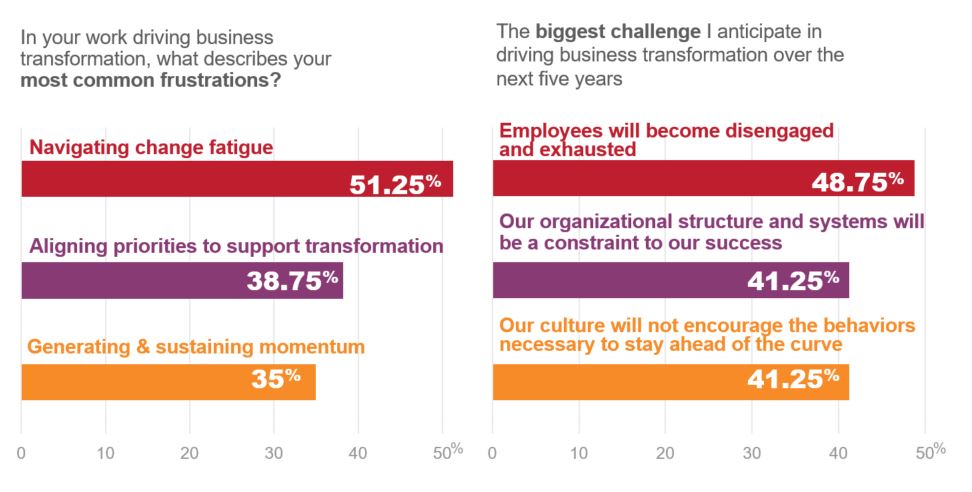This blog is presented by the IPR Organizational Communication Research Center.
We’re all taking note of the fundamental changes occurring in technology, geopolitics and culture that are driving significant change for corporations today—how we collaborate, how we communicate, and even how our organizations are structured.
Radical change has become so prevalent, we’ve had to come up with new ways of thinking about creating agile organizations, along with new acronyms, like VUCA (Volatile, Uncertain, Complex and Ambiguous), to describe this new reality. Amid so much uncertainty, a simple truth holds: Employees are indeed an organization’s most important asset. When employees become overwhelmed or bogged down by change fatigue, it can hamper an entire organization’s ability to function—let alone transform to succeed in an environment where change is the new normal.
That’s why, according to a 2016 KPMG Global Transformation study, 96 percent of organizations reported they were undergoing business transformations, but only 47 percent expected to realize sustainable value from those efforts.
In fact, an estimated 70 percent of change efforts fail outright—often due to employee resistance.
Organizations that cannot successfully navigate transformational change face serious long-term consequences. According to Innosight, in the 1930s, an S&P 500 company typically enjoyed a lifespan of more than 90 years. Today its average lifespan has shrunk to 18 years, and every two weeks another S&P 500 company falls off the list. The implications are clear: Organizations must learn to adapt, or else lapse into irrelevance.
Many organizational changes start as a digital transformation in which the mandate widens over time. Companies realize they must make significant culture changes for the technology transformation to take root. According to Gartner, 42 percent of CEOs at companies with digital transformations underway expect to undergo deep culture change by 2020. Furthermore, the same survey found 46 percent of CIOs report that culture change is their biggest barrier to success.
This is not surprising. Successful transformation is a social movement—one that individual employees join willingly. Transformation is most successful when diverse people come together for a common purpose, guided by inspiring leadership and a clear path forward.
Change leaders in today’s environment struggle most of all to manage and stay ahead of change fatigue in themselves as well as in their organizations. Gagen MacDonald surveyed participants at The Conference Board’s 2018 annual conference on change and transformation. We found that more than half of change management and business transformation leaders consider change fatigue their biggest frustration.
There is significant upside for companies who can crack the code. While Gallup reports that employee engagement has recently improved, they still estimate that $7 trillion is lost annually because of disengagement globally.
Worse, burnout is on the rise, with 23 percent of employees surveyed by Gallup saying they frequently felt burnt out. An additional 44 percent say they “sometimes” dealt with burnout. In fact, job burnout accounts for between $125 billion and $190 billion in healthcare costs every year in the U.S. Sadly, burnout is considered a widespread modern phenomenon.
Putting employees first makes a big difference. Before The Conference Board’s change communications seminar in December 2018, Gagen’s pre-event survey revealed only 39 percent of attendees said their organizations were effective at inspiring employees in this era of ongoing transformation. Yet participants agreed that putting employees first improved engagement and excitement for change.
Shifting the way people view change—from a project to a mission, from “work” to a movement—requires the ability to inspire action. People need to see a clear vision of the future and their role in creating it. Having a compelling story—the why of change—is fundamental.
An inspiring story makes all the difference in turning change initiatives from a draining experience into something energizing and future-focused. Want to defeat change fatigue and burnout? Turn change into something exhilarating by tapping into the very purpose and meaning of your organization. Evoke employees’ emotional connection to your company’s brand, colleagues, customers and purpose. Cultivate their empathy—not just through a compelling story, but through inspiring leadership and an intentional roadmap. Combining these three things—a compelling story, committed leaders and an intentional roadmap—can change everything.
What are the ways your organization is combating change fatigue? I’d love to hear what’s working for you.






